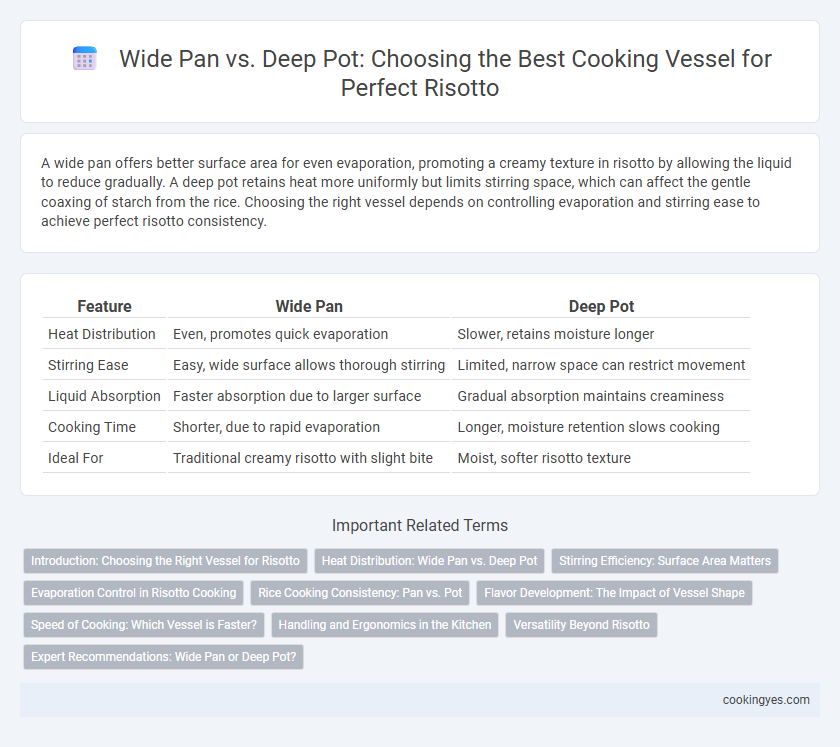A wide pan offers better surface area for even evaporation, promoting a creamy texture in risotto by allowing the liquid to reduce gradually. A deep pot retains heat more uniformly but limits stirring space, which can affect the gentle coaxing of starch from the rice. Choosing the right vessel depends on controlling evaporation and stirring ease to achieve perfect risotto consistency.
Table of Comparison
| Feature | Wide Pan | Deep Pot |
|---|---|---|
| Heat Distribution | Even, promotes quick evaporation | Slower, retains moisture longer |
| Stirring Ease | Easy, wide surface allows thorough stirring | Limited, narrow space can restrict movement |
| Liquid Absorption | Faster absorption due to larger surface | Gradual absorption maintains creaminess |
| Cooking Time | Shorter, due to rapid evaporation | Longer, moisture retention slows cooking |
| Ideal For | Traditional creamy risotto with slight bite | Moist, softer risotto texture |
Introduction: Choosing the Right Vessel for Risotto
Selecting the ideal cooking vessel for risotto significantly impacts the dish's texture and cooking process. Wide pans offer a larger surface area for faster evaporation, allowing better control over the creamy consistency essential to risotto. In contrast, deep pots retain heat longer but may require more stirring to evenly cook the rice and prevent sticking.
Heat Distribution: Wide Pan vs. Deep Pot
A wide pan provides superior heat distribution for risotto, ensuring the rice cooks evenly by maximizing contact with the heat source and allowing for consistent stirring. Deep pots often concentrate heat at the bottom, which can lead to uneven cooking and increased risk of scorching or sticking during the slow absorption process. Optimal heat control in a wide pan enhances the creamy texture and even cooking essential for classic risotto preparation.
Stirring Efficiency: Surface Area Matters
A wide pan enhances stirring efficiency in risotto preparation by providing a larger surface area, allowing rice grains to spread evenly and cook uniformly. This increased surface contact with heat promotes consistent evaporation of liquid, essential for achieving the creamy texture of risotto. In contrast, a deep pot limits surface area, making it harder to stir thoroughly and potentially leading to uneven cooking and clumping.
Evaporation Control in Risotto Cooking
Using a wide pan for risotto enhances evaporation control by allowing more surface area for moisture to escape evenly, resulting in a perfectly creamy texture. In contrast, a deep pot retains more steam, which can slow moisture evaporation and may lead to a less consistent risotto consistency. Chefs seeking precise evaporation control often prefer wide pans to achieve the ideal balance between liquid absorption and evaporation during risotto cooking.
Rice Cooking Consistency: Pan vs. Pot
Wide pans promote even rice cooking in risotto by allowing a larger surface area for consistent heat distribution and better evaporation, which helps achieve the ideal creamy texture. Deep pots can cause uneven cooking due to restricted surface exposure, often leading to clumps or soggy rice at the bottom. Optimal risotto texture relies on gradual liquid absorption and frequent stirring, both facilitated more effectively in wide pans than deep pots.
Flavor Development: The Impact of Vessel Shape
A wide pan enhances risotto flavor development by promoting even evaporation and better surface contact, which intensifies the Maillard reaction and caramelization. In contrast, a deep pot restricts surface area, slowing moisture reduction and resulting in a less concentrated taste. Optimal vessel shape directly influences the balance of creamy texture and depth of flavor in traditional risotto preparation.
Speed of Cooking: Which Vessel is Faster?
A wide pan heats the risotto more evenly and allows for faster evaporation of liquid, speeding up the cooking process compared to a deep pot. The increased surface area promotes quicker absorption of broth by the rice, enabling more efficient stirring and heat distribution. In contrast, deep pots tend to retain heat slower and may prolong cooking time due to limited surface exposure.
Handling and Ergonomics in the Kitchen
A wide pan offers superior handling and ergonomics in the kitchen for risotto preparation due to its increased surface area, which facilitates even heat distribution and easier stirring. The shallow depth allows cooks to manage ingredients effortlessly, reducing wrist strain and improving visibility of the cooking process. In contrast, a deep pot can hinder maneuverability and make continuous stirring more cumbersome, impacting the overall cooking control essential for perfect risotto consistency.
Versatility Beyond Risotto
A wide pan offers superior surface area for even evaporation, ideal for achieving the perfect risotto texture but also excels in searing meats and reducing sauces. Deep pots provide ample volume for soups, stews, and braising, making them versatile for large-batch cooking beyond risotto preparation. Choosing between these vessels depends on the desired cooking techniques and meal variety in your kitchen repertoire.
Expert Recommendations: Wide Pan or Deep Pot?
Expert recommendations for cooking risotto typically favor a wide pan over a deep pot due to better heat distribution and greater surface area, which facilitates even toasting of the rice and more efficient evaporation of liquid. A wide pan allows for consistent stirring and enhanced control over texture, preventing clumping and ensuring creamy results. Deep pots tend to trap moisture, which can lead to a less desirable, stew-like consistency instead of the ideal creamy, al dente risotto.
Wide pan vs Deep pot for cooking vessel Infographic

 cookingyes.com
cookingyes.com